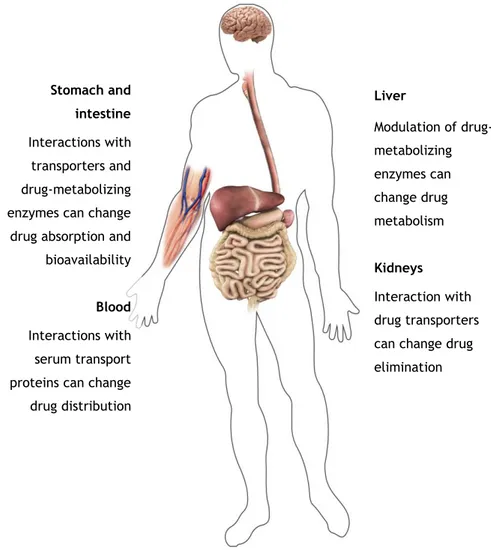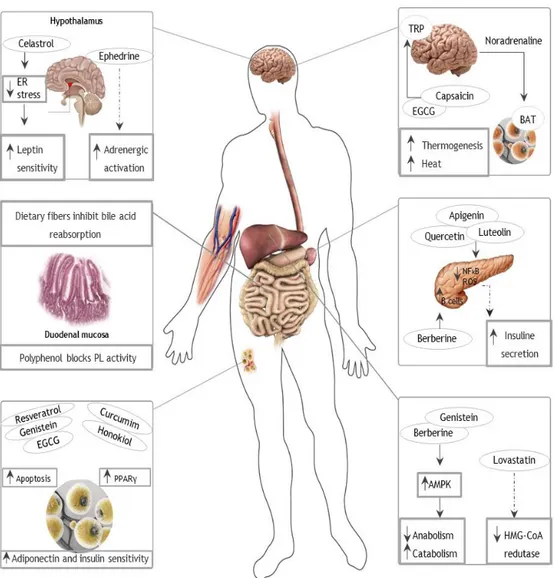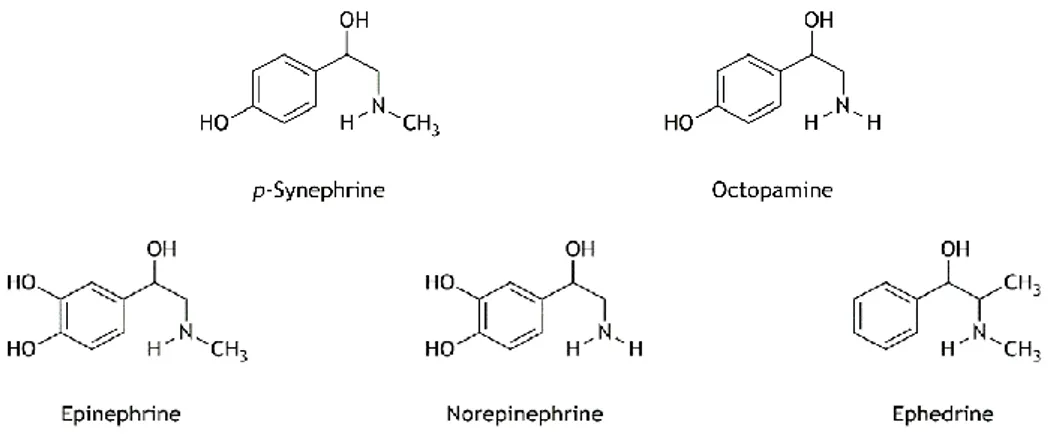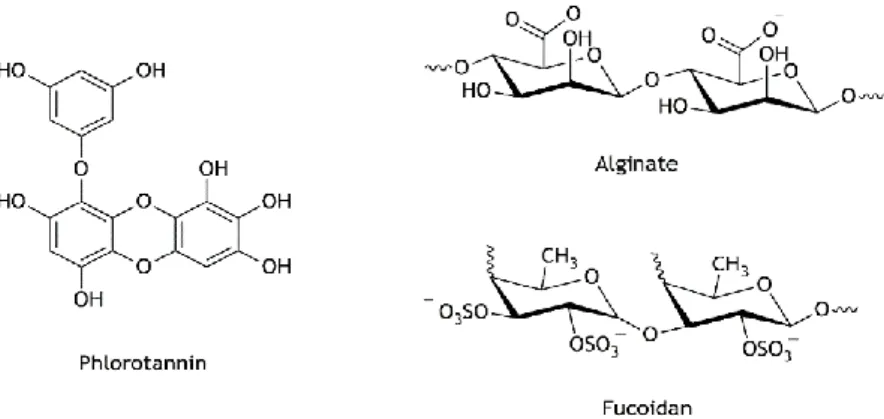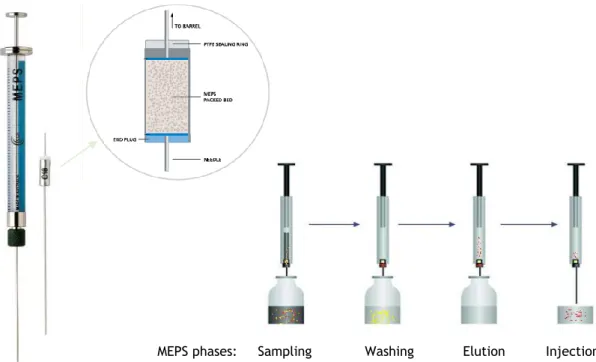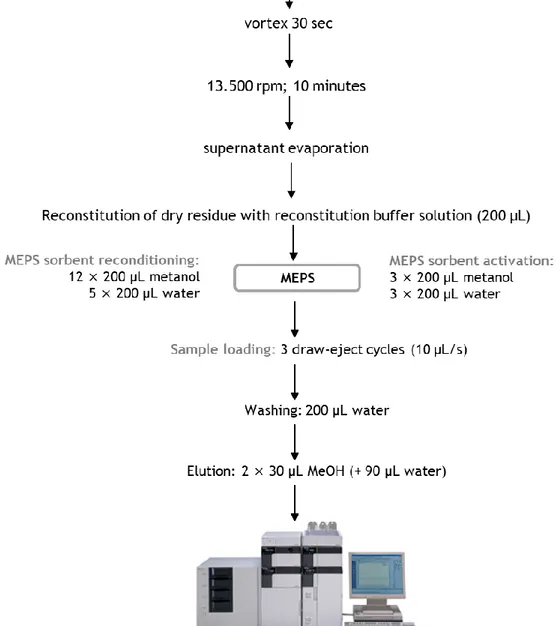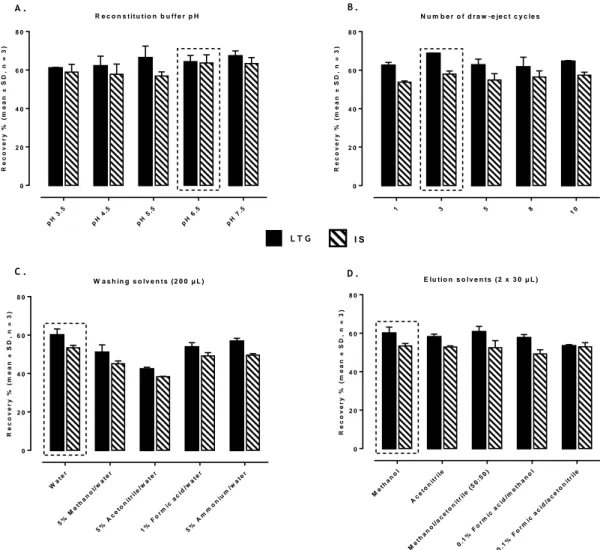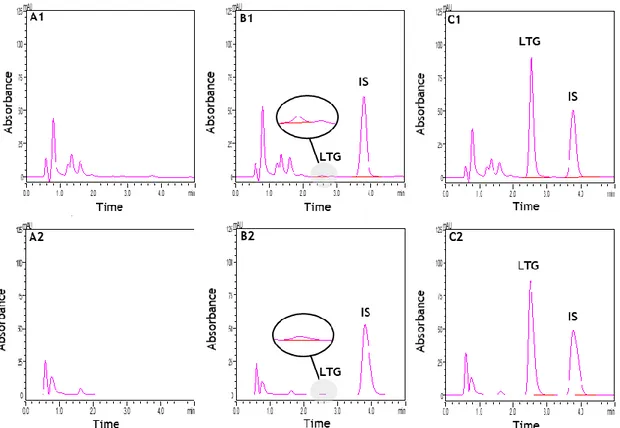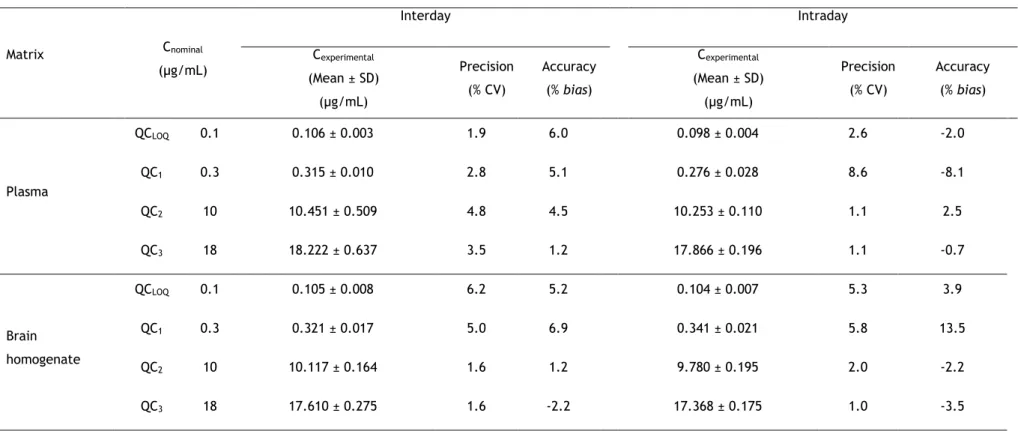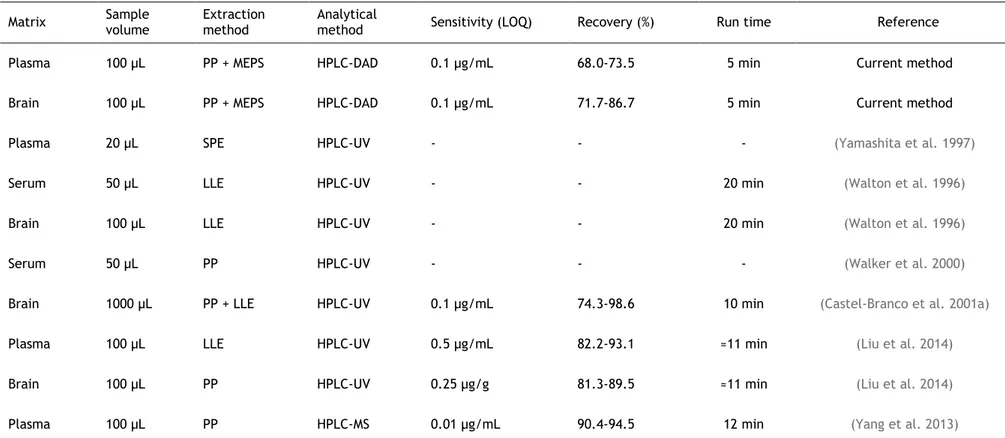UNIVERSIDADE DA BEIRA INTERIOR
Ciências
Nonclinical assessment of the potential for
herb-drug interactions between herbal extracts
present in weight loss supplements
and lamotrigine
Sandra Cristina do Espírito Santo Ventura
Tese para obtenção do Grau de Doutor em
Bioquímica
(3º ciclo de estudos)
Orientador: Prof. Doutor Gilberto Alves
Coorientador: Prof. Doutor Amílcar Falcão
The experimental work presented in this thesis was carried out at the Health Sciences Research Centre, Faculty of Health Sciences, University of Beira Interior (CICS-UBI), under the scientific supervision of Professor Gilberto Lourenço Alves (CICS-UBI, Covilhã) and Professor Amílcar Celta Falcão Ramos Ferreira (Center for Neuroscience and Cell Biology, Coimbra).
O trabalho experimental apresentado nesta tese foi realizado no Centro de Investigação em Ciências da Saúde, da Faculdade de Ciências da Saúde, da Universidade da Beira Interior (CICS-UBI), sob a orientação científica do Professor Doutor Gilberto Lourenço Alves (CICS-UBI, Covilhã) e do Professor Doutor Amílcar Celta Falcão Ramos Ferreira
The work underlying the present thesis was supported by FEDER funds through the POCI - COMPETE 2020 - Operational Programme Competitiveness and Internationalisation in Axis I - Strengthening research, technological development and innovation (Project POCI-01-0145-FEDER-007491) and National Funds by FCT - Foundation for Science and Technology (Project
UID/Multi /00709/2013).
O trabalho subjacente à presente tese teve o apoio financeiro de fundos FEDER através do POCI – COMPETE 2020 - Programa Operacional Competitividade e Internacionalização no Eixo I - Reforçar a investigação, o desenvolvimento tecnológico e a inovação (Project POCI-01-0145-FEDER-007491) e fundos Nacionais pela FCT –
Fundação para a Ciência e a Tecnologia (Project UID/Multi /00709/2013).
Não sou nada. Nunca serei nada. Não posso querer ser nada. À parte isso, tenho em mim todos os sonhos do mundo (...) O mundo é para quem nasce para o conquistar E não para quem sonha que pode conquistá-lo, ainda que tenha razão. Tenho sonhado mais que o que Napoleão fez. Tenho apertado ao peito hipotético mais humanidades do que Cristo, Tenho feito filosofias em segredo que nenhum Kant escreveu. Mas sou, e talvez serei sempre, o da mansarda
Ainda que não more nela; Serei sempre o que não nasceu para isso (...)
Agradecimentos
Agradeço ao Professor Doutor Gilberto Lourenço Alves,
pela sua sabedoria e por ser um exemplo de dedicação ao saber, à investigação e ao conhecimento, pela persistência e paciência em todas as horas de trabalho, pela orientação e por todas as palavras de incentivo e motivação ... será sempre e sem dúvida um pilar na minha formação. O meu eterno agradecimento!
Agradeço ao Professor Doutor Amílcar Falcão,
pela partilha, pelo seu notável contributo científico e pelo muito que me honra em ser coorientador do meu trabalho.
Agradeço ao Professor Doutor Márcio Rodrigues,
pois sem a sua partilha este projeto não tinha chegado a bom porto, por ser um indiscutível exemplo de dedicação à ciência e investigação.
Aos colegas do CICS,
que percorreram os mesmos corredores, as mesmas salas e laboratórios, que partilharam os momentos de alegria, as mesmas dificuldades... a todos vós, o meu muito obrigada!
Aos amigos e colegas da Escola Superior de Saúde, do Instituto Politécnico da Guarda,
pelo caminho difícil que trilhei com a vossa ajuda, a maioria das vezes impercetível aos olhos dos outros, o meu muito obrigada!
À minha mãe Trindade,
pelo apoio, pela infindável ajuda, pelo amor incondicional, pela sua capacidade em resolver todos os meus problemas. Obrigada mãe!
Ao meu pai António José,
pelo exemplo de Homem, que me acompanhou em muitos caminhos e que me ensinou a ser mais humilde! Obrigada pai!
x
Ao meu marido Tiago,
que me acompanhou nas horas complicadas, pelas dificuldades que passámos e pelos muros que se quebraram.... Obrigada por seres meu companheiro!
À Iris e Joana,
as minhas queridas filhas, quero agradecer os abraços, mesmo após tantas horas de distância, porque quis que tivessem orgulho em mim e porque trabalhei para vos fazer um pouco mais felizes. Amar-vos é um privilégio!
Table of contents
Resumo Abstract List of Figures List of Tables List of Abbreviations List of PublicationsCHAPTER I. General introduction: plants, obesity and epilepsy I.1. Plants: the medicines from nature
I.1.1. Regulatory perspective on the use of herbal medicines I.2. Herb-drug interactions
I.2.1. Pharmacokinetic herb-drug interactions I.2.2. Pharmacodynamic herb-drug interactions I.2.3. Herb-drug interactions evaluation I.3. Plants, overweight and obesity I.3.1. Paullinia cupana
I.3.2. Garcinia cambogia I.3.3. Citrus aurantium I.3.4. Fucus vesiculosus
I.4. Epilepsy and pharmacotherapeutic approaches I.4.1. Obesity and its association with epilepsy I.4.2. Pharmacotherapy in epilepsy
I.4.2.1. Selecting the best therapeutic option I.4.2.2. Enzyme induction
I.4.2.3. Enzyme inhibition
I.4.2.4. Herb-drug interactions involving antiepileptic drugs I.5. Lamotrigine
I.5.1. Physicochemical properties
I.5.2. Pharmacokinetic and pharmacodynamic properties I.5.3. Therapeutic drug monitoring of lamotrigine I.6. Aims of this thesis
CHAPTER II. Bioanalysis of lamotrigine
II.1. Bioanalytical methods for lamotrigine quantification II.1.1. Liquid chromatographic methods
II.1.2. Sample preparation procedures
II.1.2.1. Microextraction by packed sorbent assay: a brief overview II.1.3. Validation of bioanalytical methods
xix xxiii xxvii xxxv xli xlvii 1 3 5 7 8 12 13 14 17 20 23 25 27 28 30 34 38 39 39 41 43 44 47 48 51 53 54 56 57 59
xiv
II.2. Experimental Section - An easy-to-use liquid chromatography assay for the analysis of lamotrigine in rat plasma and brain samples using microextraction by packed sorbent: application to a pharmacokinetic study
II.2.1. Introduction
II.2.2. Material and methods II.2.2.1. Materials and reagents II.2.2.2. Blank rat matrices
II.2.2.3. Stock solutions, calibration standards and quality control samples II.2.2.4. Sample preparation and extraction
II.2.2.5. Apparatus and chromatographic conditions II.2.2.6. Method validation
II.2.2.7. Method application and pharmacokinetic analysis II.2.3. Results and discussion
II.2.3.1. Optimization of chromatographic conditions
II.2.3.2. Development and optimization of sample extraction procedure II.2.3.3. Method validation
II.2.3.3.1. Selectivity
II.2.3.3.2. Calibration curves and LOQ II.2.3.3.3. Precision and accuracy II.2.3.3.4. Recovery
II.2.3.3.5. Stability
II.2.3.3.6. Method application and pharmacokinetics II.2.4. Conclusion
II.3. Experimental Section - Determination of lamotrigine in human plasma and saliva using microextraction by packed sorbent and high performance liquid chromatography–diode array detection: an innovative bioanalytical tool for therapeutic drug monitoring
II.3.1. Introduction
II.3.2. Material and methods II.3.2.1. Materials and reagents
II.3.2.2. Stock solutions, calibration standards and QC samples II.3.2.3. Apparatus and chromatographic conditions
II.3.2.4. Sample preparation and extraction II.3.2.5. Method validation
II.3.2.6. Clinical application II.3.3. Results and discussion II.3.3.1. Method validation II.3.3.1.1. Selectivity
II.3.3.1.2. Calibration curves and LOQ II.3.3.1.3. Precision and accuracy
61 63 64 64 65 65 66 67 67 68 69 69 70 71 71 72 75 75 76 76 78 81 83 85 85 85 85 86 86 88 88 88 88 89 91
II.3.3.1.4. Recovery II.3.3.1.5. Stability
II.3.3.1.6. Clinical application II.3.4. Conclusion
CHAPTER III. Effects of Paullinia cupana extract on lamotrigine pharmacokinetics in rats: a herb-drug interaction on the gastrointestinal tract with potential clinical impact
III.1. Introduction
III.2. Material and Methods
III.2.1. Herbal extract, drugs and materials III.2.2. Animals
III.2.3. Preparation of herbal extract and lamotrigine solutions III.2.4. Systemic pharmacokinetic studies
III.2.5. Plasma-to-brain biodistribution study III.2.6. Liquid chromatography analysis III.2.7. Pharmacokinetic analysis
III.2.8. Effects of repeated-dose administration of P. cupana extract on biochemical parameters
III.2.9. Effects of repeated-dose administration of P. cupana extract on body weight III.2.10. Statistical analysis
III.3. Results
III.3.1. Effects of P. cupana extract on LTG pharmacokinetics after co-administration
III.3.2. Effects of repeated-dose pretreatment with P. cupana extract on LTG pharmacokinetics
III.3.3. Effects of P. cupana extract on the LTG plasma-to-brain biodistribution after co-administration
III.3.4. Effects of repeated-dose administration of P. cupana extract on biochemical parameters
III.3.5. Effects of repeated-dose administration of P. cupana extract on body weight III.4. Discussion
III.5. Conclusion
CHAPTER IV. Administration of Garcinia cambogia and lamotrigine: safety evidence from non-clinical pharmacokinetic studies in Wistar rats
IV.1. Introduction
IV.2. Material and Methods
IV.2.1. G. cambogia extract and drugs IV.2.2. Animals
IV.2.3. Preparation of G. cambogia extract and LTG solutions IV.2.4. Pharmacokinetic studies
91 91 91 96 97 99 100 100 100 101 101 102 102 103 103 103 104 104 104 106 107 109 110 110 113 115 117 118 118 118 119 119
xvi IV.2.5. LTG quantification
IV.2.6. Pharmacokinetic analysis
IV.2.7. Effects of repeated-dose administration of G. cambogia extract on body weight
IV.2.8. Statistical analysis IV.3. Results
IV.3.1. Effects of G. cambogia extract on LTG pharmacokinetics after co-administration
IV.3.2. Effects of repeated-dose pre-treatment with G. cambogia extract on LTG pharmacokinetics
IV.3.3. Effects of repeated-dose administration of G. cambogia extract on body weight
IV.4. Discussion IV.5. Conclusion
CHAPTER V. Evaluation of the effects of Citrus aurantium (bitter orange) extract on lamotrigine pharmacokinetics: insights from in vivo studies in rats
V.1. Introduction
V.2. Material and Methods
V.2.1. C. aurantium extract, drugs and materials V.2.2. C. aurantium extract and lamotrigine solutions V.2.3. Animal experiments
V.2.4. Pharmacokinetic studies V.2.5. Lamotrigine analysis V.2.6. Pharmacokinetic analysis
V.2.7. Evaluation of repeated-dose administration of C. aurantium extract on biochemical parameters
V.2.8. Evaluation of repeated-dose administration of C. aurantium extract on body weight
V.2.9. Statistical analysis V.3. Results
V.3.1. Effects of C. aurantium extract on LTG pharmacokinetics after co-administration
V.3.2. Effects of repeated-dose pretreatment with C. aurantium extract on LTG pharmacokinetics
V.3.3. Evaluation of repeated-dose administration of C. aurantium extract on biochemical parameters
V.3.4. Evaluation of repeated-dose administration of C. aurantium extract on body weight V.4. Discussion V.5. Conclusion 120 120 120 120 121 121 123 124 125 127 129 131 132 132 132 133 133 134 134 134 135 135 135 135 137 138 139 139 141
CHAPTER VI. Safety evidence on the administration of Fucus vesiculosus L. (bladderwrack) extract and lamotrigine: data from pharmacokinetic studies in the rat
VI.1. Introduction
VI.2. Material and Methods VI.2.1. Herbal extract and drugs
VI.2.2. Herbal extract and lamotrigine solutions VI.2.3. Animals
VI.2.4. Pharmacokinetic studies VI.2.5. Lamotrigine quantification VI.2.6. Pharmacokinetic analysis
VI.2.7. Evaluation of repeated-dose administration of F. vesiculosus extract on body weight
VI.2.8. Statistical analysis VI.3. Results
VI.3.1. Effects of F. vesiculosus extract on LTG pharmacokinetics after co-administration
VI.3.2. Effects of repeated pre-treatment with F. vesiculosus extract on LTG pharmacokinetics
VI.3.3. Effects of repeated-dose administration of F. vesiculosus extract on body weight
VI.4. Discussion VI.5. Conclusion
CHAPTER VII. General discussion CHAPTER VIII. Conclusion
REFERENCES 143 145 146 146 146 146 147 147 148 148 148 149 149 150 152 153 154 155 165 169
Resumo
As plantas têm sido, e continuarão ainda a ser, uma das fontes mais importantes de princípios ativos. Na realidade, as plantas constituem ainda a “espinha dorsal” das farmacopeias modernas e continuam a ser uma fonte de novos candidatos a fármacos. A utilização de plantas medicinais ou de preparações medicinais à base de plantas está também a aumentar em muitos países desenvolvidos como uma forma alternativa e complementar para o tratamento de doenças. Por conseguinte, o uso concomitante de plantas e medicamentos convencionais é uma prática comum em doentes com hipertensão, diabetes, epilepsia, depressão e doenças oncológicas, assim como em pessoas com obesidade e excesso de peso. Recentemente, a obesidade e a epilepsia têm sido consideradas comorbilidades com uma elevada prevalência, particularmente em doentes com epilepsia refratária e polimedicados. O tratamento de doentes com epilepsia deve, portanto, ter em consideração que a presença de comorbilidades pode comprometer a eficácia e a segurança dos fármacos antiepiléticos, os quais constituem a principal estratégia terapêutica na epilepsia. A lamotrigina (LTG) é um fármaco antiepilético bem tolerado e amplamente utilizado na epilepsia, mas que apresenta uma margem terapêutica estreita e uma variabilidade interindividual considerável na sua farmacocinética. Por isso, o foco de investigação considerado nesta tese foi a avaliação não-clínica do potencial de interação entre extratos de plantas presentes em suplementos à base de plantas para emagrecimento e a LTG, usando o rato como modelo animal. Após a otimização e a validação de métodos bioanalíticos seletivos, precisos e exatos para a quantificação da LTG em amostras humanas (plasma e saliva) e em amostras de rato (plasma e cérebro), as condições para prosseguir com os estudos não-clínicos estavam reunidas. Portanto, de seguida, um conjunto de estudos não-clínicos foi realizado em ratos Wistar machos adultos com o objetivo principal de avaliar os efeitos de extratos padronizados de Paullinia cupana (guaraná), de Garcinia cambogia (tamarindo de Malabar), de Citrus aurantium (laranja-amarga) e de Fucus vesiculosus (bodelha) na cinética da LTG. Para tal, pelo menos dois estudos farmacocinéticos independentes foram realizados para avaliar os efeitos de cada extrato na farmacocinética da LTG; o primeiro estudo teve como objetivo avaliar os efeitos após a coadministração do extrato e da LTG, e o segundo estudo foi realizado para avaliar os efeitos de um período de pré-tratamento de 14 dias com cada extrato na farmacocinética da LTG administrada subsequentemente ao 15º dia. Globalmente, os resultados dos estudos farmacocinéticos envolvendo os quatro extratos de plantas revelaram que o extrato de P. cupana é aquele que tem maior potencial para interagir com a LTG, enquanto que os extratos de G. cambogia, C. aurantium e F. vesiculosus tiveram poucos ou nenhuns efeitos na farmacocinética da LTG. A coadministração do extrato de P. cupana e LTG causou, em particular, um decréscimo significativo da concentração plasmática máxima (Cmax) e da extensão de exposição sistémica
xxii
uma interação farmacocinética importante entre o extrato de P. cupana e a LTG foi aqui descrita pela primeira vez, a qual potencialmente pode ter impacto clínico em doentes tratados com a LTG. Além disso, a administração repetida dos extratos testados durante um período de 14 dias não teve efeitos relevantes sobre o ganho de peso corporal dos ratos, o que levanta dúvidas sobre a eficácia deles na redução do peso corporal. Assim, em conclusão, a avaliação não-clínica de interações planta-fármaco é de extrema importância para antecipar os efeitos potenciais de preparações à base de plantas na farmacocinética de fármacos de índice terapêutico estreito como a LTG, constituindo esses dados o ponto de partida para confirmação posterior e investigação da relevância dessas interações a nível clínico.
Palavras-chave
Extratos de plantas, fármacos antiepiléticos, farmacocinética, interações planta-fármaco, lamotrigina, rato.
Abstract
Plants have been and still continue to be one of the most important sources of active ingredients. Actually, plants are still the backbone of modern pharmacopoeias and remain as a source of new drug candidates. The use of medicinal plants or plant-based medicinal products is also increasing in many developed countries as an alternative and complementary form for the treatment of diseases. Thus, the concomitant use of plants and conventional medications is emerging as a common practice in patients with hypertension, diabetes, epilepsy, depression, and oncological diseases, as well as in people with obesity and being overweight. Recently, obesity and epilepsy have been related as comorbid conditions with a high prevalence, particularly in patients with refractory epilepsy and under polytherapy. Treatment of patients with epilepsy should, therefore, take into account that the presence of comorbid conditions may compromise the efficacy and safety of antiepileptic drugs, which constitute the main therapeutic approach in epilepsy. Lamotrigine (LTG) is a well-tolerated antiepileptic drug widely used in epilepsy; however, it has a narrow therapeutic range and a considerable interindividual variability in its pharmacokinetics. Therefore, the focus of research addressed in this thesis was the nonclinical assessment of the potential for herb-drug interactions between herbal extracts present in weight loss supplements and LTG, using the rat as whole animal model. After optimization and validation of selective, precise and accurate bioanalytical methods for the quantification of LTG in human samples (plasma and saliva) and in rat samples (plasma and brain), the conditions for proceeding with nonclinical studies were met. Therefore, then a number of nonclinical studies were performed in adult male Wistar rats with the main objective of evaluating the effects of standardized extracts of Paullinia cupana (guarana), Garcinia cambogia (malabar tamarind), Citrus aurantium (bitter orange) and Fucus vesiculosus (bladderwrack) on the kinetics of LTG. To this end, at least two independent pharmacokinetic studies were carried out to evaluate the effects of each herbal extract on the pharmacokinetics of LTG; the first study aimed to evaluate the effects after the co-administration of the extract and LTG, and the second one aimed to evaluate the effects of a 14-day pre-treatment period with the extract on the pharmacokinetics of LTG subsequently administered on the 15th day.
Globally, the results of the pharmacokinetic studies involving the four herbal extracts pointed out that P. cupana extract is the one that has higher potential to interact with LTG, while G. cambogia, C. aurantium and F. vesiculosus extracts had minor or no effects on LTG pharmacokinetics. The co-administration of P. cupana extract and LTG caused, in particular, a significant decrease in the peak plasma drug concentration (Cmax) and in the extent of systemic
exposure to LTG over the first 24 h (AUC0-24). Based on the findings achieved in these nonclinical
studies, an important pharmacokinetic interaction between P. cupana extract and LTG was herein described for the first time, which potentially may have clinical impact in patients treated with LTG. Moreover, the repeated administration of the tested herbal extracts during
xxvi
a 14-day period did not have relevant effects on the body weight gain of rats, which raises doubts about their effectiveness in reducing body weight. So, in conclusion, the nonclinical assessment of herb-drug interactions is of utmost importance to anticipate the potential effects of herbal preparations in the pharmacokinetics of narrow therapeutic index drugs like LTG, constituting these data the starting point for further confirmation and investigation of the relevance of these interactions at a clinical level.
Keywords
Antiepileptic drugs, herbal extracts, herb-drug interactions, lamotrigine, pharmacokinetics, rat.
List of Figures
Figure I.1. Main sites for potential pharmacokinetic-based herb-drug interactions. 11 Figure I.2. Anti-obesity effects of some plant substances (AMPK, AMP-activated
protein kinase; BAT, brown adipose tissue; EGCG, epigallocatechin gallate; ER, endoplasmatic reticulum; HMG-CoA, 3-hydroxy-3-methyl glutaryl-coenzyme A; NFκB, nuclear factor κ-light-chain-enhancer of activated B cells; PL, pancreatic lipase; PPARγ, peroxisome proliferator-activated receptor γ; ROS, reactive oxygen species; TRP, transient
receptor potential channels on sensory nerves). 16
Figure I.3. Chemical structures of methylxanthines present in Paullinia cupana. 17 Figure I.4. Caffeine effects in thermogenesis and energy intake (cAMP, cyclic
adenosine monophosphate). 18
Figure I.5. Chemical structures of hydroxycitric acid and hydroxycitric acid lactone
present in Garcinia cambogia. 21
Figure I.6. Chemical structures of p-synephrine and octopamine present in Citrus
aurantium and related compounds. 24
Figure I.7. Chemical structures of alginate, fucoidan and phlorotannin present in
Fucus vesiculosus. 26
Figure I.8. Classification of epilepsies. 28
Figure I.9. Lamotrigine (LTG) and its metabolites chemical structures. LTG-2-N-glucuronide is the major metabolite in humans; LTG-2-N-methyl is
mostly found in dogs and LTG-2-N-oxide in rats. 43
Figure II.1. Schematic representation of the microextraction by packed sorbent
(MEPS) procedure. 58
Figure II.2. Schematic representation of lamotrigine sample preparation involving a combination of protein precipitation and microextraction by packed
sorbent (MEPS). 66
Figure II.3. Effect of different MEPS conditions on the extraction efficiency of lamotrigine (LTG) and internal standard (IS): influence of the reconstitution buffer pH (A), number of draw-eject cycles at pH 6.5 (B),
different washing solutions (C) and elution solvents (D). 71 Figure II.4. Typical chromatograms of extracted rat plasma and brain homogenate
samples obtained by the method developed: blank plasma (A1) and blank brain homogenate (A2); plasma (B1) and brain homogenate (B2) spiked
xxx
with the internal standard (IS) and lamotrigine (LTG) at the lower limit of quantification (0.1 µg/mL); and plasma (C1) and brain homogenate (C2) spiked with the IS and LTG at the concentration of the upper limit
of calibration range (20 µg/mL). 72
Figure II.5. Representative chromatograms of the analysis of real samples of rat plasma and brain homogenate: at 24 h post-dose in plasma (A1) and brain homogenate (A2), and at 72 h post-dose in plasma (B1) and brain
homogenate (B2). 77
Figure II.6. Mean plasma concentration-time profile of lamotrigine (LTG), over a period of 72 h, obtained from rats treated with a single dose of LTG (10 mg/kg) administered by oral gavage. Symbols represent the mean values ± standard error of the mean (SEM) of five determinations per time point (n = 5, unless otherwise indicated). The concentration of LTG in a brain homogenate sample collected at 24 h post-dose (n = 1) is also represented; at 72 h post-dose the brain concentrations of LTG were
found at BLQ levels in all rats analysed (n = 4). 78 Figure II.7. Chemical structure of lamotrigine (LTG) and chloramphenicol (CAM) used
as internal standard (IS). 83
Figure II.8. Typical chromatograms of extracted human plasma and saliva samples obtained by the MEPS/HPLC-DAD method developed: blank plasma (a) and saliva (b); plasma (c) and saliva (d) spiked with the internal standard (IS) and lamotrigine (LTG) at the LOQ (0.1 µg/mL); and plasma (e) and saliva (f) spiked with the IS and LTG at the concentration of the upper
limit of the calibration range (20 µg/mL). 90
Figure II.9. Representative chromatograms of the analysis of real plasma (a) and saliva (b) samples at 2 h post-dose obtained from the patients treated
with lamotrigine (LTG). IS, internal standard. 95
Figure II.10. Concentration-time profiles of lamotrigine (LTG) obtained from plasma and saliva samples collected at 2, 4, 8 and 12 h post-dose (taking as reference the morning dose) in two patients (ID1 and ID2) under oral LTG therapy (ID1, 100 mg once-daily in the morning; ID2, 150 mg in the morning, and 200 mg at night in cotherapy with valproic acid). The corresponding salivary to plasma LTG concentration ratios were also calculated at 2, 4, 8 and 12 h post-dose and graphically represented for
both patients. 95
Figure III.1. Mean plasma concentration-time profiles of lamotrigine (LTG) obtained, over a period of 96 h, from rats co-administered with a single-dose of Paullinia cupana extract (821 mg/kg, p.o.) or vehicle of the extract
(water) and LTG (10 mg/kg, p.o.) by oral gavage. Symbols represent the mean values ± standard error of the mean (SEM) of six determinations per time point (n = 6). *p < 0.05 and **p < 0.005 compared to control
(vehicle). 105
Figure III.2. Mean plasma concentration-time profiles of lamotrigine (LTG) obtained, over a period of 96 h, from rats submitted to a 14-day pre-treatment period with Paullinia cupana extract (821 mg/kg/day, p.o.) or vehicle of the extract (water), and treated on the 15th day with a single-dose of
LTG (10 mg/kg, p.o.) by oral gavage. Symbols represent the mean values ± standard error of the mean (SEM) of six determinations per time point
(n = 6). *p < 0.05 compared to control (vehicle). 106 Figure III.3. Mean plasma and brain tissue concentrations of lamotrigine (LTG),
obtained at 6 h post-dose, from rats co-administrated with a single-dose of Paullinia cupana extract (821 mg/kg, p.o.) or vehicle (water) and LTG (10 mg/kg, p.o.) by oral gavage. Data are presented as the mean values ± standard error of the mean (SEM) of five determinations (n = 5). **p <
0.005 compared to control (vehicle). 108
Figure III.4. Effects of Paullinia cupana extract on biochemical parameters (blood glucose, total cholesterol and triglycerides) after a 14-day treatment period with Paullinia cupana extract (821 mg/kg/day, p.o.) or vehicle (water) by oral gavage. Data are presented as the mean values ± standard error of the mean (SEM) of six determinations (n = 6). *p < 0.05
and **p < 0.005 compared to control (vehicle). 109 Figure III.5. Effects of Paullinia cupana extract on the body weight of rats after a
14-day treatment period with Paullinia cupana extract (821 mg/kg/14-day, p.o.) or vehicle (water) by oral gavage. Data are presented as the mean values ± standard error of the mean (SEM) of six determinations (n = 6).
**p < 0.005, day 1 versus day 14. 110
Figure IV.1. Mean plasma concentration-time profiles of lamotrigine (LTG) obtained, over a period of 96 h, from rats co-administered with a single-dose of Garcinia cambogia extract (821 mg/kg, p.o.) or vehicle of the extract (water) and LTG (10 mg/kg, p.o.) by oral gavage. Symbols represent the mean values ± standard error of the mean (SEM) of six determinations
per time point (n = 6). 121
Figure IV.2. Mean plasma concentration-time profiles of lamotrigine (LTG) obtained, over a period of 96 h, from rats submitted to a 14-day pre-treatment period with Garcinia cambogia extract (821 mg/kg/day, p.o.) or vehicle of the extract (water) and treated on the 15th day with a single-dose of
xxxii
LTG (10 mg/kg, p.o.) by oral gavage. Symbols represent the mean values ± standard error of the mean (SEM) of six determinations per time point
(n = 6). 123
Figure IV.3. Effects of Garcinia cambogia extract on the body weight of rats after a 14-day treatment period with Garcinia cambogia extract (821 mg/kg/day, p.o.) or vehicle (water) by oral gavage. Data are presented as the mean values ± standard error of the mean (SEM) of six
determinations (n = 6). **p < 0.005, day 1 versus day 14. 125 Figure V.1. Mean plasma concentration-time profiles of lamotrigine (LTG) obtained,
over a period of 96 h, from rats co-administered with a single-dose of Citrus aurantium extract (164 mg/kg, p.o.) or vehicle of the extract (water) and LTG (10 mg/kg, p.o.) by oral gavage. Symbols represent the mean values ± standard error of the mean (SEM) of six determinations
per time point (n = 6). 136
Figure V.2. Mean plasma concentration-time profiles of lamotrigine (LTG) obtained, over a period of 96 h, from rats submitted to a 14-day pre-treatment period with Citrus aurantium extract (164 mg/kg, p.o.) or vehicle of the extract (water) and treated on the 15th day with a single-dose of LTG (10
mg/kg, p.o.) by oral gavage. Symbols represent the mean values ± standard error of the mean (SEM) of six determinations per time point (n
= 6). 137
Figure V.3. Effects of Citrus aurantium extract on biochemical parameters (blood glucose, total cholesterol and triglycerides) of rats after a 14-day treatment period with Citrus aurantium extract (164 mg/kg, p.o.) or vehicle (water) by oral gavage. Data are presented as the mean values ±
standard error of the mean (SEM) of six determinations (n = 6). 139 Figure V.4. Effects of Citrus aurantium extract on the body weight of rats after a
14-day treatment period with Citrus aurantium extract (164 mg/kg, p.o.) or vehicle (water) by oral gavage. Data are presented as the mean values ± standard error of the mean (SEM) of six determinations (n = 6).
**p < 0.005, day 1 versus day 14. 140
Figure VI.1. Mean plasma concentration-time profiles of lamotrigine (LTG) obtained, over a period of 96 h, from rats co-administered with a single-dose of Fucus vesiculosus extract (575 mg/kg, p.o.) or vehicle of the extract (water) and LTG (10 mg/kg, p.o.) by oral gavage. Symbols represent the mean values ± standard error of the mean (SEM) of six determinations
Figure VI.2. Mean plasma concentration-time profiles of lamotrigine (LTG) obtained, over a period of 96 h, from rats submitted to a 14-day pre-treatment period with Fucus vesiculosus extract (575 mg/kg, p.o.) or vehicle of the extract (water) and treated on the 15th day with a single-dose of LTG (10
mg/kg, p.o.) by oral gavage. Symbols represent the mean values ± standard error of the mean (SEM) of six determinations per time point (n
= 6). 151
Figure VI.3. Effects of Fucus vesiculosus extract on the body weight of rats after a 14-day treatment period with Fucus vesiculosus extract (575 mg/kg, p.o.) or vehicle (water) by oral gavage. Data are presented as the mean values ± standard error of the mean (SEM) of six determinations (n = 6).
List of Tables
Table I.1. Antiepileptic drugs (AEDs) therapeutic indications according to seizure
types (adapted from NICE guideline CG137). 34
Table I.2. Antiepileptic drugs (AEDs) therapeutic indications according to epilepsy syndromes (adapted from NICE guideline CG137). 35 Table I.3. Pharmacokinetic parameters and serum reference ranges of the major
antiepileptic drugs (AEDs). 36
Table I.4. Elimination routes of antiepileptic drugs (AEDs). 40 Table II.1. Intra and interday precision (% CV) and accuracy (% bias) values obtained
for lamotrigine (LTG) in rat plasma and brain homogenate samples at the lower limit of quantification (QCLOQ), and at low (QC1), middle (QC2)
and high (QC3) concentration levels representative of the calibration
ranges (n = 5). 73
Table II.2. Comparison of key bioanalytical aspects (sensitivity, extraction efficiency/recovery and run time) between the current method and previous methods used for the bioanalysis of lamotrigine in rat
plasma/serum and brain homogenate samples. 74
Table II.3. Recovery (values in percentage) of lamotrigine (LTG) from rat plasma and brain homogenate samples at low (QC1), middle (QC2) and high (QC3)
concentrations of the calibration ranges (n = 5). 75 Table II.4. Stability (values in percentage) of lamotrigine (LTG) at low (QC1) and
high (QC3) concentrations of the calibration ranges, in unprocessed rat
plasma and brain homogenate samples at room temperature for 4 h, at 4 ºC for 24 h, and at -20 ºC for 30 days; and in processed rat plasma and brain homogenate samples left in the HPLC autosampler for 12 h (n = 5). 76 Table II.5. Pharmacokinetic parameters estimated by non-compartmental analysis
of the individual plasma concentration-time profiles of lamotrigine (LTG) obtained in rats (n = 5) after a single oral dose of LTG (10 mg/kg). 77 Table II.6. Retention times (RT) in minutes (min) of tested drugs potentially
co-prescribed with lamotrigine (LTG). 89
Table II.7. Intra and interday precision (% RSD) and accuracy (% bias) values obtained for lamotrigine (LTG) in human plasma and saliva at the limit of quantification (QCLOQ) concentration and at low (QC1), medium (QC2)
and high (QC3) concentrations representative of the calibration ranges
xxxviii
Table II.8. Comparison of determinant bioanalytical aspects between the current method and previous methods used for the bioanalysis of lamotrigine in
human plasma and saliva samples. 93
Table II.9. Recovery (values in percentage) of lamotrigine (LTG) from human matrices (plasma and saliva) at low (QC1), medium (QC2) and high (QC3)
concentrations of the calibration range (n = 5). 93 Table II.10. Stability (values in percentage) of lamotrigine (LTG) at low (QC1) and
high (QC3) concentrations of the calibration range in unprocessed and
processed human plasma and saliva samples (n = 5). 94 Table III.1. Pharmacokinetic parameters estimated by non-compartmental analysis
of the plasma concentration-time profiles of lamotrigine (LTG) obtained in rats after the co-administration with a single-dose of Paullinia cupana extract (821 mg/kg, p.o.) or vehicle of the extract (water) and LTG (10 mg/kg, p.o.) by oral gavage (n = 6). Data are presented as mean values ± standard error of the mean (SEM), except for tmax that is expressed as
median values (range). 105
Table III.2. Pharmacokinetic parameters estimated by non-compartmental analysis of the plasma concentration-time profiles of lamotrigine (LTG) obtained in rats submitted to a 14-day pre-treatment period with Paullinia cupana extract (821 mg/kg, p.o.) or vehicle of the extract (water), and treated on the 15th day with a single-dose of LTG (10 mg/kg, p.o.) by
oral gavage (n = 6, unless otherwise noted). Data are presented as mean values ± standard error of the mean (SEM), except for tmax that is
expressed as median values (range). 107
Table IV.1. Pharmacokinetic parameters estimated by non-compartmental analysis of the plasma concentration-time profiles of lamotrigine (LTG) obtained in rats after the co-administration with a single-dose of Garcinia cambogia extract (821 mg/kg, p.o.) or vehicle of the extract (water) and LTG (10 mg/kg, p.o.) by oral gavage (n = 6). Data are presented as mean values ± standard error of the mean (SEM), except for tmax that is
expressed as median values (range). 122
Table IV.2. Pharmacokinetic parameters estimated by non-compartmental analysis of the plasma concentration-time profiles of lamotrigine (LTG) obtained in rats submitted to a 14-day pre-treatment period with Garcinia cambogia extract (821 mg/kg, p.o.) or vehicle of the extract (water) and treated on the 15th day with a single-dose of LTG (10 mg/kg, p.o.)
error of the mean (SEM), except for tmax that is expressed as median
values (range). 124
Table V.1. Pharmacokinetic parameters estimated by non-compartmental analysis of the plasma concentration-time profiles of lamotrigine (LTG) obtained in rats after the co-administration with a single-dose of Citrus aurantium extract (164 mg/kg, p.o.) or vehicle of the extract (water) and LTG (10 mg/kg, p.o.) by oral gavage (n = 6). Data are presented as mean values ± standard error of the mean (SEM), except for tmax that is
expressed as median values (range). 136
Table V.2. Pharmacokinetic parameters estimated by non-compartmental analysis of the plasma concentration-time profiles of lamotrigine (LTG) obtained in rats submitted to a 14-day pre-treatment period with Citrus aurantium extract (164 mg/kg/day, p.o.) or vehicle of the extract (water) and treated on the 15th day with a single-dose of LTG (10 mg/kg,
p.o.) by oral gavage (n = 6). Data are presented as mean values ± standard error of the mean (SEM), except for tmax that is expressed as
median values (range). 138
Table VI.1. Pharmacokinetic parameters estimated by non-compartmental analysis of the plasma concentration-time profiles of lamotrigine (LTG) obtained in rats after the co-administration with a single-dose of Fucus vesiculosusextract (575 mg/kg, p.o.) or vehicle of the extract (water) and LTG (10 mg/kg, p.o.) by oral gavage (n = 6). Data are presented as mean values ± standard error of the mean (SEM), except for tmax that is
expressed as median values (range). 150
Table VI.2. Pharmacokinetic parameters estimated by non-compartmental analysis of the plasma concentration-time profiles of lamotrigine (LTG) obtained in rats submitted to a 14-day pre-treatment period with of Fucus vesiculosusextract (575 mg/kg, p.o.) or vehicle of the extract (water) and treated on the 15th day with a single-dose of LTG (10 mg/kg, p.o.)
by oral gavage (n = 6). Data are presented as mean values ± standard error of the mean (SEM), except for tmax that is expressed as median
List of
Abbreviations
List of Abbreviations
A
AED Antiepileptic drug
ADME Absorption, distribution, metabolism, and excretion AUC Area under the concentration-time curve
AUC0-24 AUC from time zero to 24 h
AUC0-t AUC from time zero to the last measurable concentration
AUC0-∞ AUC from time zero to infinite
B
Bias Deviation from nominal concentration C
Clast Last quantifiable concentration
Cmax Peak plasma concentration
CNS Central nervous system CV Coefficient of variation
CYP Cytochrome P450
D
DAD Diode array detector
DGAV Portuguese National Authority for Animal Health, Phytosanitation and Food Safety (Direção Geral de Alimentação e Veterinária)
E
EMA European Medicines Agency F
FDA Food and Drug Administration G
GABA -Aminobutyric acid
GACP Good Agricultural and Collection Practice H
HCA Hydroxycitric acid HDI Herb-drug interaction
xliv
HPLC High-performance liquid chromatography HMPC Committee on Herbal Medicinal Products 5-HT 5-Hydroxytryptamine
I
ICH International Conference on Harmonisation ILAE International League Against Epilepsy i.p. Intraperitoneal
IS Internal standard
K
kel Apparent terminal elimination rate constant
Km Half-maximal rate of metabolism
L
LD50 Median lethal dose
LLE Liquid-liquid extraction LOQ Limit of quantification LOD Limit of detection
LTG Lamotrigine
M
MEPS Microextraction by packed sorbent MRT Mean residence time
MS Mass spectrometry
O
OAT Organic anion transporters
OATP Organic anion transporting polypeptides OCT Organic cations transporters
P
PEPT Peptide transporters P-gp P-glycoprotein
p.o. Per os
PP Protein precipitation Q
R
r2 Determination coefficient
Rpm Rotations per minute S
SEM Standard error of the mean SPE Solid-phase extraction SPME Solid-phase microextraction T
TDM Therapeutic drug monitoring tmax Time to reach Cmax
TSH Thyroid-stimulating hormone
t1/2el Apparent terminal elimination half-life
U
UGT Uridine diphosphate-glucuronosyltransferase
UV Ultraviolet
V
Vd Apparent volume of distribution
Vmax Maximal rate of metabolism
W
List of
Publications
List of Publications
Ventura, S., Rodrigues, M., Pousinho, S., Falcão, A., Alves, G. (2016). An easy-to-use liquid chromatography assay for the analysis of lamotrigine in rat plasma and brain samples using microextraction by packed sorbent: Application to a pharmacokinetic study. Journal of Chromatography B 1035: 67–75.
Ventura, S., Rodrigues, M., Pousinho, S., Falcão, A., Alves, G. (2017). Determination of lamotrigine in human plasma and saliva using microextraction by packed sorbent and high performance liquid chromatography–diode array detection: An innovative bioanalytical tool for therapeutic drug monitoring. Microchemical Journal 130: 221–228.
Ventura, S., Rodrigues, M., Falcão, A., Alves, G. (2018). Effects of Paullinia cupana extract on lamotrigine pharmacokinetics in rats: A herb-drug interaction on the gastrointestinal tract with potential clinical impact. Food and Chemical Toxicology 115: 170-177. Ventura, S., Rodrigues, M., Falcão, A., Alves, G. Administration of Garcinia cambogia and
lamotrigine: Safety evidence from non-clinical pharmacokinetic studies in Wistar rats (submitted for publication).
Ventura, S., Rodrigues, M., Falcão, A., Alves, G. (2018). Evaluation of the effects of Citrus aurantium (bitter orange) extract on lamotrigine pharmacokinetics: Insights from in vivo studies in rats. Food and Chemical Toxicology 121: 166-172.
Ventura, S., Rodrigues, M., Falcão, A., Alves, G. (2018). Safety evidence on the administration of Fucus vesiculosus L. (bladderwrack) extract and lamotrigine: Data from pharmacokinetic studies in the rat. Drug and Chemical Toxicology, https://doi.org/10.1080/01480545.2018.1518454.
Chapter I.
General
introduction:
plants, obesity and
epilepsy
General introduction: plants, obesity and epilepsy
I.1. Plants: the medicines from nature
Plants have been one of the most important and primary sources of medicines throughout the history of mankind. They have never been old or dispensable, and their importance in modern civilizations is as remarkable as it was in ancient times when men depended on them to survive, either as a food source or in cultural and religious traditions. In this new era of herbal renaissance, plants are still the backbone of modern pharmacopoeias, and constitute an emerging source of new drug candidates, as prototypes or lead compounds (Mishra and Tiwari 2011; Pferschy-Wenzig and Bauer 2015; Sponchiado et al. 2016). The first pure natural product drug prototypes were identified through the investigation of vascular plants. These plant-derived medicines include morphine (from Papaver somniferum), digitoxin (from Digitalis purpurea), salicylic acid (from Salix alba), quinine (from Cinchona sp), atropine (from Atropa belladonna) and paclitaxel (from Taxus brevifolia). Terrestrial animals were also a source of therapeutics like captopril (from the viper Bothrops jararaca) and epibatidine (from the frog Epipedobates anthonyi) (Bernardini et al. 2017; Mushtaq et al. 2018). Indeed, over the last decades, about 40% of the new chemical entities approved by the Food and Drug Administration (FDA) were natural products or natural-based products (including semi-synthetic derivatives, synthetic compounds based on natural pharmacophores and natural products mimetics), and mostly from plant origin (Chen et al. 2015; Katz and Baltz 2016). Despite the intensive investigation of the terrestrial flora, it is estimated that only 6% of the approximately 300,000 species of higher plants have been systematically and pharmacologically investigated, and only 15% phytochemically investigated (Cragg and Newman 2013; Mushtaq et al. 2018).
The diversity and richness of secondary metabolites in plants have been exploited along the years, following the development of powerful analytical tools based upon genomics, proteomics, metabolomics and bioinformatics (Harvey et al. 2015; Ngo et al. 2013; Sharma and Shrivastava 2016). The biosynthesis of secondary metabolites occurs mainly through the shikimate, acetate–malonate and acetate–mevalonate pathways, usually in response to environmental stress (caused by temperature, water, salinity, radiation, chemical or mechanical signals), allowing plants to survive, protect themselves (from pathogens and predators) and be adapted to hostile conditions (Bernardini et al. 2017; Patra et al. 2013). Despite the enormous variety of chemical substances produced, these metabolites are often produced in low quantities and its production strongly depends on the growing and developmental stage of the plant (Ramakrishna and Ravishankar 2011). These specialized substances exhibit a variety of biological activities according to their chemical structures and are mainly organized in two groups: containing molecules (alkaloids) and nitrogen-deficient molecules (terpenoids and phenolics) (Patra et al. 2013).
Alkaloids, found in over than 20% of plant species, are low-molecular weight containing nitrogen substances that have strong pharmacological activities such as anti-tumoral (vincristine and vinblastine, from Catharanthus roseus), antimalarial (quinine, from Cinchona
Chapter I.
4
sp.), cholinergic (pilocarpine, from Pilocarpus sp.), anticholinergic (atropine, from Atropa belladonna), adrenergic (ephedrine, from Ephedra), anaesthetic (cocaine, from Erythroxylum coca) and analgesic (like morphine from Papaver somniferum), among others (Shitan 2016). Additionally, many alkaloids mimic, block or modulate neurotransmitter activity or interfere with basic neurological functions. Biosynthetically, true and non-heterocyclic alkaloids are derived from amino acids, such as phenylalanine, ornithine, arginine, tyrosine, and tryptophan (from shikimate and acetyl-coenzyme A pathways). However, others are originated from alternative precursors (e.g. purine-derived caffeine) (Staniek et al. 2013).
Terpenoids are lipid-soluble substances, synthetized mostly from the mevalonate pathway, which include an enormous variety of compounds classified according to the number of isoprene units. They exhibit a broad range of pharmacological activities, including antimicrobial (essential oils, from Thymus sp. and Mentha piperita), sedative and anxiolytic (valepotriates, from Valeriana officinalis), antioxidant (essential oil, from Melissa officinalis), anti-tumoral (diterpenes, from Taxus sp.), nootropic (ginkgolides and bilobalide, from Ginkgo biloba), ionotropic (cardenolides, from Digitalis purpurea), analgesic (cannabinoids, from Cannabis sativa), neuroprotective (ginsenosides, from Panax ginseng), among others (Kennedy and Wightman 2011; Staniek et al. 2013; Staniek et al. 2014).
Plant phenols are one of the most common and widespread group of substances, formed by the shikimate/phenylpropanoid pathways. They have at least one aromatic ring, with one or more hydroxyl substituents, and include several subgroups: phenylpropanoids, coumarins, lignans, flavonoids, and tannins. From these, flavonoids represent the largest and most diverse group, encompassing some 6000 compounds, which include anthocyanins, proanthocyanidins, chalcones, flavones, flavonols, flavanones, and isoflavones. Similarly, they have different biological effects such as antibacterial and scavenger of free radicals (polyphenols, from Camellia sinensis), antidepressant effects (flavonoids and hipericins, from Hypericum perforatum), anti-inflammatory effects (salicylic acid, from Salix sp.) and cardioprotective and oestrogen-like activity (isoflavones from Glycine max), among others (Bernardini et al. 2017; Bjørklund et al. 2017; Kennedy and Wightman 2011; Latteef 2016).
Besides the important bioactivities of secondary metabolites, plant primary metabolites are also important in food and pharmaceutical industries, as well as in traditional medicine. For example, fatty acids (in olive oil, as cardioprotective) and carbohydrates (honey, as antibacterial and wound dressing) play an important role in modern medicine (Molan and Rhodes 2015; Schwingshackl and Hoffmann 2014; Waterman and Lockwood 2007).
Pharmaceutical investigations have learned from plant chemistry and have targeted their knowledge to synthetize and extract both secondary and primary metabolites as drugs to treat diseases. Despite the sophisticated advances in chemically synthetic approaches to drug design and structure-activity relationship analysis, pharmaceutical investigations are again focused in the potential of plants as source of novel compounds with unique mechanisms of action. Most of the new drug discovery research programs are based on traditional medicine-based strategies to increase success and ensure the safety of new drugs (Yuan et al. 2016). There is no doubt
General introduction: plants, obesity and epilepsy
that traditional medicines truly protected human society since antiquity and the “learning from nature, learning from our ancestors” are still supporting society in medication, research and development (Leonti and Verpoorte 2017).
I.1.1. Regulatory perspective on the use of herbal medicines
From the descriptions and therapeutic knowledge of the De Materia Medica (from Dioscorides, 1st century CE) it is easy to understand the importance of herbal medicines (Atanasov et al. 2015; Chinou et al. 2014; Staub et al. 2016). Several plants have been used for thousands of years and are still used across all over the world. Plants and herbal medicines are important for human health care as an integral part of traditional medical systems. It is estimated that 70% of the world's population does not have access to conventional medicines and, therefore, rely on traditional treatments as their primary source of healthcare (Pferschy-Wenzig and Bauer 2015).
Herbal medicines differ in many features from conventional medicines, and several aspects bring a variety of challenges in what concerns to their pharmacovigilance, namely the plant substitution and adulteration, the lack of uniformity in nomenclature, quality control and standardization and the lack of monitoring the adverse reactions (de Boer et al. 2015; Osathanunkul et al. 2016).
The World Health Organization (WHO) defined herbal medicines as plant-derived products or preparations (like extracts and tinctures) constituted by one or more ingredients from one or more plants, used with therapeutic or other human health benefits (Pferschy-Wenzig and Bauer 2015). Due to the complex phytochemical mixtures that are present in some of the plant-derived products or preparations, the European Medicines Agency (EMA) differentiated the herbal medicinal products in three categories: (a) standardized products, with a given content of chemically defined substances or substances with known therapeutic activity; (b) quantified products, with a defined range of active markers, that are constituents or groups of constituents that generally contribute to the therapeutic activity; and (c) other herbal products, in which neither constituents with therapeutic activity nor active markers are known. In this case, the extract as a whole is regarded as the active principle (Pferschy-Wenzig and Bauer 2015).
Recognizing that there is a worldwide variation in what concerns the regulatory policies on the use of herbal medicines, one of the most acceptable approaches to quality assurance is the primary standardization of the active constituents and/or analytical markers. Phytochemical profiling and metabolite fingerprinting are already increasing tools to ensure this goal. Nevertheless, the quality assurance in terms of chemical composition alone does not bring consistent therapeutic efficacy and/or safety of the herbal medicines (Bansal et al. 2016). Indeed, international regulatory guidelines have been redefined to ensure the manufacturing and controlling of herbal medicines in terms of quality, safety and efficacy. But, like other drugs, herbal medicines must also ensure stability, consistent therapeutic efficacy and safety throughout the defined herbal medicinal products shelf life (Bansal et al. 2016). Guidelines
Chapter I.
6
from EMA, FDA and WHO already require stability data for the finished herbal product (EMA 2011b; ICH 2003; WHO 2006). It is important to emphasize that efficacy and safety of these finished products are directly dependent on the quality and chemistry of medicinal herb raw materials (Govindaraghavan and Sucher 2015). To ensure both safety and efficacy of herbal medicines, implementation of good agricultural and collection practices (GACP), good plant authentication and identification practices, and good manufacturing practices before and during the manufacturing process, as well as good laboratory practices are mandatory. The authenticity of herbal medicines starting materials free of impurities (heavy metals contamination, pesticide residues, and aflatoxins/mycotoxins) is another major step to ensure the quality of finished herbal medicinal products (Govindaraghavan and Sucher 2015). In Europe, there are specific guidelines of GACP (EMEA/HMPC/246816/2005) and on efficacy, safety and quality of herbal medicinal products (Peschel 2014). Additionally, the International Conference on Harmonisation (ICH) provides ground rules for validation of analytical methods, which in turn ensure the method suitability and ruggedness as a quality measure across multiple laboratories (Govindaraghavan and Sucher 2015; ICH 2005).
Complementary sources of information about herbal medicines are available in specific herbal medicines databases (such as THINKherb and TCMID), and in different collections of monographs on selected medicinal herbs, like in the American Herbal Pharmacopoeia, the British Herbal Pharmacopoeia, the German Commission E, the United States Pharmacopoeia, and the European Pharmacopoeia (Chinou et al. 2014; Pan et al. 2013; Shaw et al. 2012). The WHO had published 117 monographs in four volumes (WHO 1999–2009) and the European Pharmacopoeia include already more than 250 general methods on analysis, being 166 of herbal substances, and more than one hundred of herbal preparations (i.e. extracts, tinctures, essential oils, starches, fatty oils and waxes) (Chinou et al. 2014; Peschel 2014; Vlietinck et al. 2009). European Union herbal monographs, formerly known as Community herbal monographs, are important to support herbal medicinal products registration and authorization. These herbal monographs comprise the scientific opinion of the Committee on Herbal Medicinal Products (HMPC), an EMA committee responsible for compiling and assessing scientific data on herbal substances, that supports the harmonization of the European market on herbal medicinal products. Each monograph includes information about qualitative and quantitative composition, pharmaceutical form(s), therapeutic indication(s), posology and method of administration, contraindications, special warnings and precautions for use, information about interactions with other medicinal products, uses in special populations, effects on ability to drive and use machines, undesirable effects and toxicity information, as well as pharmacodynamic and pharmacokinetic properties and existing preclinical safety data (Chinou et al. 2014).
Herbal medicinal products can be regarded to as well-established and traditional use products in European Union according to Directive 2004/24/EC amending Directive 2001/83/EC
(Chinou et al. 2014; Peschel 2014). A traditional medicinal herbal product must follow standards of safety and quality and there must be an evidence that the product (or an equivalent product)
General introduction: plants, obesity and epilepsy
has been in use as a traditional medicinal product for at least 30 years (15 years of which must be in the European Union). HMPC responsibilities, in this matter, include the establishing of herbal monographs, covering the therapeutic uses and safety conditions of well-established and traditional use, and also to list the herbal substances, preparations and combinations thereof for use in traditional herbal medicinal products [Commission implementing decision (EU) 2016/1658, amending Decision 2008/911/EC]. Until December 2012, a total of 1015 registrations as traditional use and 514 authorisations as well-established use have been registered for about 200 different herbal drugs (Peschel 2014). So, it is highly probable that Europe leads the market of herbal products due to the development of effectiveness, quality, and safety standards, based on the robust control of the manufacture and delivery of plant medicines through all stages of production (Alonso-Castro et al. 2015).
In Portugal, herbal products consumption and commercialization are legally regulated according to their categories as dietary supplements (Decreto-Lei n.º 118/2015),plant or plant-based preparations, traditional herbal medicines or plant-plant-based medicines (Decreto-Lei n.º 176/2006).
I.2. Herb-drug interactions
The use of herbal medicines is increasing in many countries. However, it is difficult to evaluate the extent of its use since they can be marketed as dietary supplements, functional foods or cosmetics (Pferschy-Wenzig and Bauer 2015). Concomitant intake of herbal medicines and prescribed medication is also a very common practice, especially in patients with hypertension, diabetes, cancer, epilepsy and depression (Awortwe et al. 2018). The incidence of herb-drug interactions (HDIs) is not really known and the lack of these data may be due to under-reporting or unrecognized interactions. Patients can apparently tolerate adverse effects remarkably well, and many interactions can be accommodated and the effects may not consciously be recognized as the result of an interaction (Williamson et al. 2009).
The reporting use of herbal medicines by consumers can also contribute to the under-reporting adverse effects since they believe that herbal medicines are safe due to its natural origin, even if they are consumed at the same time than prescribed drugs. Particularly, elderly and polymedicated patients are more susceptible to the use of these herbal medicines and, therefore, they are also more likely to suffer from potential interactions between herbs and drugs (Alissa 2014; Li et al. 2016). However, the risk of HDIs is already recognized as a public health problem that can lead to life-threatening adverse drug events, prolonged hospitalization and even death (Awortwe et al. 2018).
Due to the increasing use of herbal medicines and supplements by the general population, the research about HDIs has been accelerated (Choi et al. 2016). A review of the literature by Posadzki et al. (2013) identified fifty systematic reviews reporting adverse effects of herbal medicines, although associated with moderately severe or minor adverse effects. In another
Chapter I.
8
review were identified adverse drug reactions due to HDIs in fifteen of the reviewed case reports and observational studies. From these, eight patients had central nervous system (CNS) diseases, including two with epilepsy (Awortwe et al. 2018).
As it was previously mentioned, herbal products can contain more than one plant or plant-product, with a complex mixture of bioactive substances or phytochemicals that may act synergistically or additively to exhibit a proper biological and pharmacological activity (Alissa 2014; Brantley et al. 2014; Carmona and Pereira 2013; Oga et al. 2016). So, it is quite difficult to evaluate the individual contribution of each herbal substance for the interaction with other drugs.
Additionally, herbal substances are often administered in combination with conventional drugs, raising the potential of pharmacokinetic and/or pharmacodynamic interactions (He et al. 2010). These HDIs may have clinical relevance when the metabolizing enzymes and transporters responsible for the fate of many drugs are induced or inhibited, resulting in unexpected, and sometimes, fatal consequences (Oga et al. 2016). Indeed, HDIs can be the result of a combination of acute effects (inhibition) and repeated effects (induction) on the drug-metabolizing enzymes and/or transporters.
I.2.1 Pharmacokinetic herb-drug interactions
Contrary to the development of conventional medicines, herbal medicines are usually not studied from a pharmacokinetic point of view, but it seems that most of the pharmacokinetic principles are applied to them. Pharmacokinetic interactions involving herbal medicines can occur at the absorption, distribution, metabolism and excretion levels, the so-called ADME interactions (Alissa 2014), with direct effects on the extent of systemic exposure to drugs and/or metabolites, that is generally observed in the dose-response relationship. Pharmacokinetic-based HDIs can become clinically significant when considerable changes occur in the pharmacokinetic parameters of the co-administered drug that are directly related to the drug’s efficacy and toxicity, such as the area under the concentration-time curve (AUC), peak plasma concentration (Cmax) or time to reach Cmax (tmax) (Tarirai et al. 2010). AUC is indeed the
pharmacokinetic parameter that primarily reflects the extent of drug bioavailability (Hsueh et al. 2017). So, the risk of pharmacokinetic interactions entails two major challenges: pharmacotoxicity and treatment failure (Fasinu et al. 2012).
Most herbal medicines are administered orally in a chronic regimen (He et al. 2010). The bioavailability of herbal substances is dependent on many pre-systemic processes that include solubility in the gastrointestinal fluid and membrane permeability, degradation in the gastrointestinal tract, transporter-mediated intestinal efflux, pre-systemic gut wall and hepatic metabolism. Flavonoids, for example, are poorly absorbed due to their large molecular weight and poor solubility in the lipid-rich outer membranes of the enterocytes. Additionally, some flavonoids can be effluxed by P-glycoprotein (P-gp) and others can be extensively susceptible to first-pass metabolism in the gut or in the liver (He et al. 2010).
General introduction: plants, obesity and epilepsy
Herbal medicines can also alter the absorption of concomitantly administered drugs mostly by causing changes in the gastrointestinal pH and in other biochemical factors that can alter dissolution properties and the absorption of pH-dependent drugs. Other mechanisms like complexation and chelation may lead to the formation of insoluble complexes and competition at the sites of absorption, changing the extent of absorption of drugs. The concomitant use of drugs with anthranoid-containing plants like cassia (Cassia senna), cascara (Rhamnus purshiana), rhubarb (Rheum officinale), and soluble fibres can decrease drug absorption by decreasing gastrointestinal transit time (Fasinu et al. 2012).
The extent of protein binding is another factor that affects the ability of one drug to be distributed and have therapeutic or toxic effects. If an herbal substance has affinity to bind serum proteins, it may compete with other drugs for binding to proteins. Displacement of therapeutic agents from binding sites on serum proteins will increase their rates of elimination, and sudden displacement of drugs from serum proteins can increase the free drug concentration to toxic levels (Sprouse and Van-Breemen 2016).
The metabolism of herbal substances shares the same drug-metabolizing proteins, including cytochrome P450 (CYP) enzymes and uridine diphosphate-glucuronosyltransferases (UGTs). It is also true that phytochemicals and drugs share the same transport proteins such as P-gp, from the ATP-binding cassette (ABC) family of transporters, influencing the drug biodisposition. Indeed, some herbal substances are known to influence both transporters and enzymes function.Due to the high expression of P-gp on the epithelial cells lining the intestine, these transporters may change the absorption and bioavailability of herbal substances, being so determinant on its pharmacokinetics, efficacy and toxicity. Additionally, P-gp can be found in the canalicular membranes of hepatocytes, kidney proximal tubules, and brain endothelial cells
(Kumar et al. 2010).P-gp has been shown to exhibit up to five substrate binding sites involved in the transport of numerous hydrophobic, amphipathic, cationic and neutral molecules. Thus, P-gp is responsible for extruding a variety of drugs from cells, potentiating multidrug resistance
(Han 2011). In the kidneys and liver, P-gp is related to the excretion of toxic substances and in the intestine P-gp-mediated efflux can reduce the bioavailability of drugs that are administered orally. At the blood-brain barrier (BBB), P-gp prevents the entrance of drugs into the CNS. Kaempferol and quercetin are some of the herbal substances that can modulate P-gp activity
(Kumar et al. 2010). Other herbal compounds have been reported to be substrates of other drug transporters such as multidrug-resistance associated proteins (MRPs) or breast cancer resistance protein (BCRP). Although less documented, solute-carrier (SLC) protein transporters responsible for the uptake of organic anions [organic anion transporting polypeptides (OATPs) and organic anion transporters (OATs)], organic cations [organic cation transporters (OCTs)], peptides [peptides transporters (PEPTs)], and multidrug and toxic compound extrusion (MATE) transporters implicated in the efflux of metabolic waste products and xenobiotics have also been related to HDIs. For instance, the flavonoids apigenin, quercetin and kaempferol block the transporter functions of OATP1A2 and OATP2B1, which are localized in the apical membrane of the intestinal lumen (Husain et al. 2016). Ellagic acid, caffeic acid and rhubarb
